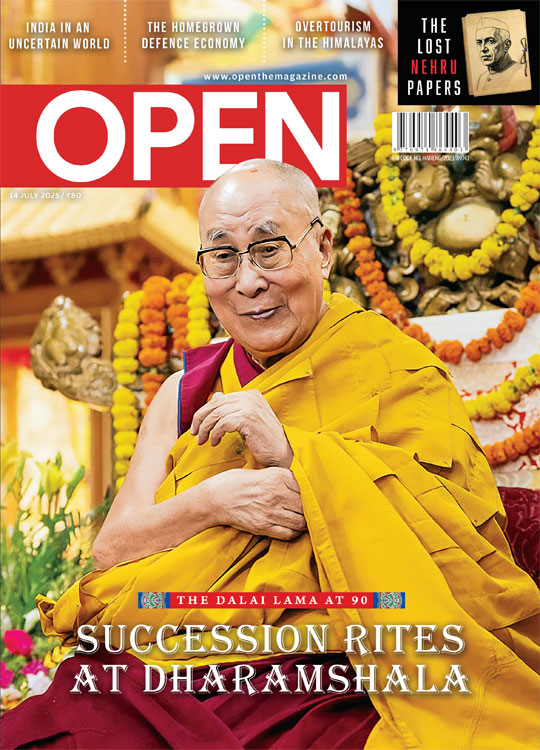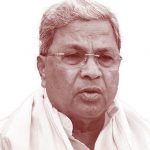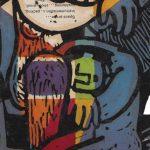/wp-content/uploads/2016/07/Writtenonface1a.jpg)
I AM USUALLY A NOUN, I can be a verb. I can cascade down in ribbons, be twirled to stand at attention, sculpted into twirls across visages, plaited and rubber-banded, dyed and gelled. I like to feel the wind blow through me on long and empty roads. The touch of whisky sends a shiver down my spine. I am tickled easily and quiver at a touch. I have a penchant for grabbing food and not letting go. When I’m not cultivated with care, I grow as wild as wild can be. I find myself out of place in boardrooms and hotel kitchens; boxing rings and battlefronts are not for me.
I’ve donned the cheeks and draped the necks of the greatest men in history from Moses to Jesus Christ, Charles Darwin to Rabindranath Tagore. Salvador Dali took me in directions no one ever has. I still think of him with a twang in my heart. I have made Ben Affleck and George Clooney look even sexier than they did (who even knew that was possible?).
Veterans, who have done much and are unsure what they will do next, such as David Letterman, David Beckham and Al Gore have embraced me. In the pages of The New Yorker, and on the chins of the aforementioned, I have been called ‘a marker of triumphant lassitude, the victory lap after a long job well done’. Most recently, Jon Stewart did me proud. And I made him even more distinguished. I must confess, I look good on older faces and in sombre colours—Senior Bachchan makes me bristle with delight. Rajinikanth in his most recent avatar gives me cause to blush. But don’t be mistaken, I am not prejudiced against the young. Thanks to me, Virat Kohli stands a cut above the rest. Arjun Rampal has served my cause well, as has Saif Ali Khan at times. Rahul Gandhi is such a tease: occasionally he embraces me and at others abandons me completely. I wish he’d make up his mind.
But Indian men have been good to me. The stars from Tamil Nadu and Kerala, Karnataka and Andhra Pradesh wear me like a badge of honour. My best friends can be found in Punjab. And to them, I am eternally thankful.
Oils warm the cockles of my heart. Water is not always my best friend. Lather gets me into a tizzy. I never know what is to follow. Will it be a comforting shampoo or something far more perilous? Blades are the death of me. The tragedy is that I can be done away with altogether. But I make men of boys, and for that I will always be remembered.
I am the beard.
THE BEARD HAS had a long and uneven history, with appearances and disappearances. England of the 18th century was almost entirely clean shaven. Victorian men, however, took a liking to them. It is said the 70s was the decade of the handle- bar moustache. The 80s saw the rise of the Magnum PI swathe of hair above the upper lip. The 90s preferred the clean shaven look. And now we are seeing the rise of the beard. It is probably just a matter of a decade or two before the handlebar moustache makes a full-blown comeback. While it might be tempting to dismiss the hair (or the lack thereof) from male faces as fashion and grooming frippery, we all know better. Fashion reflects our time. As Christopher R Oldstone-Moore says, ‘Whenever masculinity is redefined, facial hairstyles change to suit. The history of men is literally written on their faces.’ Oldstone-Moore should know what he’s talking about; for the last decade, this historian with a PhD from University of Chicago has been researching hair and is the author of the well-acclaimed book, Of Beards and Men (2015). In an email interview, the senior lecturer at Wright State University says, ‘We are currently seeing more men wearing beards around the globe. There is no single reason. There is a trend towards religious traditionalism. But that is not all. In Western societies, there is less eagerness to be a ‘company man’, and more interest in asserting a personal identity and style. Masculinity is less group-oriented and more personal… We are living in an experimental time and it is difficult to predict where things will go from here.’
Back in 2014, Procter & Gamble noticed that demand for razors had fallen. Today in India we are seeing the rise of beard products and beard clubs. Actors and models are more willing to sport beards, news anchors strut them, college campuses are rife with them. In a time defined by extremes and excesses, the unusual and the unknown, the beard has become a way to assert control and establish uniqueness. While websites and books throw up countless tips on how to fashion beards and groom them, truth be told there are far more ways to have a beard than not have one. It is in the possibilities it carries and the potential it holds for individual faces that beards are unique. Here is a brief list of the many types of beards and moustaches that do exist—the full beard, goatee, stubble, sideburns, chinstrap, moustache, horseshoe moustache, handle-bar moustache, soul patch and mutton chops. To have facial hair is not just to have facial hair, but it is to have bespoke hair, that which can be tailored to individual specifications.
While it might be tempting to dismiss facial hair as fashion frippery, we all know better. Fashion reflects our time
At a time when ‘gender as performance’ is taken for granted, Oldstone-Moore writes, cutting or shaping facial hair becomes not just a means to express manliness, but to be men. It would be absurd to ignore the social stipulations around the beard and to see it merely as an individualistic pursuit. Facial hair is political, and it is policed; any public school boy will attest to that.
In India, trends often arise from Bollywood. What happens on screen and in theatres slowly wends its way into our lives and onto our faces. Over the last few years, Ranveer Singh has done much for the beard. In 2013, with Goliyon Ki Raasleela Ram-Leela, the beard swathes much of his face, and the moustache is twirled to perfection. The following year, in Gunday, he was seen with sideburns, the handlebar and a chinstrap. Most recently, in Bajirao Mastani, the moustache goes Daliesque, and the stubble, rogue.
Ranveer Singh’s stylist and Bollywood insider Nitasha Gaurav (who works with other leading men such as Arjun Kapoor and Ayushmann Khurrana) says, “The beard has been part of the alpha characters that Ranveer has played over the last few years. He is such a major style icon that the trend has caught on. The beard looks so good on him, but it has also added a dimension to the characters he’s played.” Singh has shown that irrespective of whether he is playing a coal don of the early 80s, or a Peshwa of the 18th century, facial hair has added both gravitas and authenticity to his character. Gaurav agrees that we have seen the rise of the beard over the last two-three years, but it is only of late that it has become well accepted.
In a time defined by extremes and excesses, the unusual and the unknown, the beard has become a way to establish uniqueness
Ahmedabad-based Ashutosh Valani and Priyank Shah are cashing into this acceptance of the beard. They launched the website Beardo (with the tagline: ‘Everything a Man Needs; Home Delivered’) just a year ago. Valani, who has been working in the online retail space for a decade, says that while Beardo catered to 500-1,000 customers per month when it was first launched, today it fulfills 20,000-30,000 orders per month. They have recently started exporting their products to the US and Gulf countries as well.
WITH VALANI AND Shah totting well-manicured facial hair themselves, the idea of the site arose as they had found “the beard was a pain point for us, because there were no good products for it”. In a bid to solve this knotty problem, they launched Beardo, which offers a range of products such as beard oil, beard growth oil, beard wash, beard combs and beard wax. They have even launched an under eye gel. Valani waxes eloquent about the difference between face hair, scalp hair and body hair, and the need of different caregivers for each. He says, “When we started, we didn’t think it would pick up this quickly. But now everybody seems to be keeping a beard. It is better than the peeled potato face.” Demand for Beardo items does not come only from the metros, he says—men from West Bengal to Madhya Pradesh, Gujarat to Punjab, Tamil Nadu to Uttar Pradesh have made a beeline to the site.
Valani says Beardo distinguishes itself from other brands that offer male grooming products because it caters solely to men, unlike numerous Indian and international beauty lines that started off catering to women and then latched onto the male grooming market. For years men have mooched off their mothers’, sisters’ and wives’ beauty products. It is high time they got their own, he says.
Steven Wilson, a ‘lifelong beard advocate’ based in California, started Beards.org in 1996 to ‘foster greater appreciation, admiration and acceptance of beards’. The site is part tribute, part encyclopaedia, part photo gallery to the beard. The Facebook page has 409,000 followers today, out of which, Wilson says, Indian followers are second in number only to those in the US. In terms of rank, New Delhi is No 1, Bangalore No 2—outdoing even London and New York.
But what would explain this rise of beards? What does it tell us about manhood today? Nitasha Gaurav says that this global trend is a move away from the “pretty meterosexual look towards a more lumberjack look”. A return to the 70s is reflected not only in facial hair, but also in fashion—the flared pants, the billowing blouse, the chequered shirts. “Fashion is a reflection of society. In the 70s we saw a similar political upheaval. There were student movements then as there are now. You basically don’t know what you will wake up to in the morning,” she says. Tough times give rise to long beards.
Blessed with luscious facial hair growth, the beard is both an object of pride and concern for the Indian man. It is also an important uniting factor. Vishal Singh, founder of the Bangalore Beard Club, would agree. A wedding planner, he started the Club in May this year to “unite bearded men and to create a brotherhood”. He says that while most Indian men can easily grow beards, few of them know how to groom them. The 31-year-old, who personally uses a beard oil, beard shampoo, beard conditioner, beard dryer and beard comb, grew his beard only two years ago. For 10 years he worked in the hospitality industry, which forbade beards, compelling him to shave twice a day. Since quitting that job, he hasn’t shaved completely and there has been no turning back since. He says, “The outlook of people has changed completely [since I grew a beard]. Beards command a lot of respect. People respond well. And one gets lots of compliments from women.”
While the Bangalore Beard Club might have more than 6,000 ‘likes’ on Facebook, Singh makes it clear that membership is exclusive and selective. What are the criteria? “To be selected, men need to have very well-groomed beards and a good personality,” he says, “I want to recruit people who might look like villains but are totally not.”
And therein lies the rub. The beard hints at revolt and freedom, it could be a beacon of individuality, an attempt to seize control in chaotic times or merely a sign of a very rushed morning. And the only person who knows the truth is the beard wearer himself.

/wp-content/uploads/2025/07/Cover_Dalai-Lama.jpg)















More Columns
From Entertainment to Baiting Scammers, The Journey of Two YouTubers Madhavankutty Pillai
Siddaramaiah Suggests Vaccine Link in Hassan Deaths, Scientists Push Back Open
‘We build from scratch according to our clients’ requirements and that is the true sense of Make-in-India which we are trying to follow’ Moinak Mitra